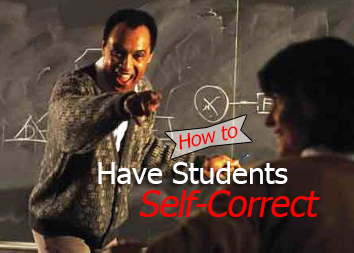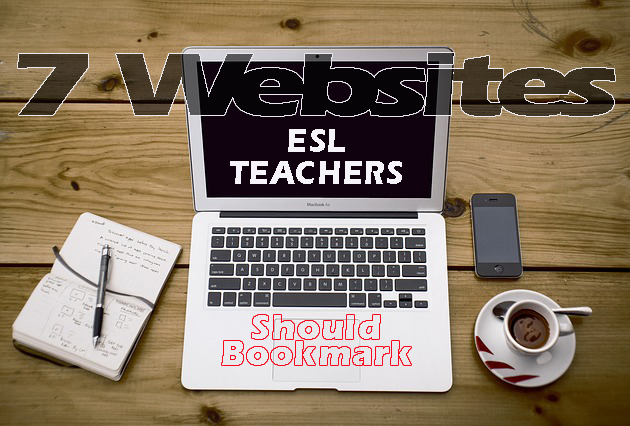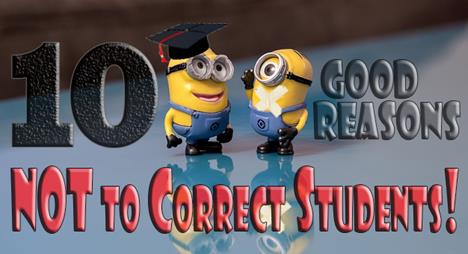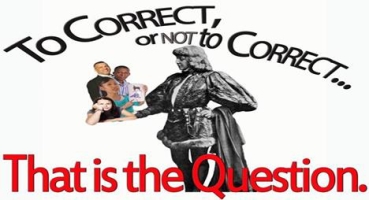Try these different ways to correct your student’s errors so you can make your job easier, your classes more effective and your student’s more aware of how to use the language they are practicing in class time.
TEACHER to STUDENT
#01. Prompting Students to Self Correct
WHAT IS THIS : Only point out a mistake has been made and students fix the mistake by themselves.
WHEN TO USE : Most effective strategy! This can be used in all stages of a lesson.
HOW TO USE : You can use different methods to point out the mistake including;
- gestures
- facial expressions
- asking a question
- echoing the student’s answer somehow highlighting the mistake
- point out the type of mistake they made
- using prompt words to lead them to the mistake
- simply asking them to say that again correctly
- [Read deeper: Nice Ways to Get Students to Self Correct Their Mistakes]
#02. Hot Correction
WHAT IS THIS : Correct the mistake for the student instantly after hearing it.
WHEN TO USE : Early on in practice activities when students are still getting familiar with the new target language.
HOW TO USE : This should and can happen fast – Detect, Correct, Repeat and Move on!
- Provide the correction (and a brief explanation if needed) and have students repeat the correction right away and carry on. Be sure to make it fast! Get in, correct, student repeats, and you get out.
- Avoid using negative language to stop the student’s speaking. Don’t say things like, that was wrong, incorrect, or no not like that like this. Instead try saying, we say it like this… / that was almost perfect please try… / one small change…
- Trying to prompt for self correction could be done first and use hot correction quickly if the student can’t self correct right away.
GROUP CORRECTION
#03. Make a List of Expected Common Errors Before Class
WHAT IS THIS : Anticipate (from experience) what mistakes most students will make and prepare a list before class.
WHEN TO USE : After practice activities have finished and you want a cumulative review on the mistakes that students make most.
HOW TO USE : Pre-composed list of errors can be presented on a white board, in a handout, or as an audio file students listen to.
- Use mistakes previous classes you taught this lesson to made, search the internet for suggested common errors, or logically guess what the difficult parts of the target language are yourself.
- Anyway you present them it is a good idea for the class to walk away with a written record of the errors and their fixes.
- Taking a photograph of board work, students correcting errors on the handout, and providing a correct utterance of the error in the audio file are all good ways of doing that respectively.
#04. Collect Student’s Errors for Feedback After the Activity
WHAT IS THIS : Quietly make a list of student’s errors heard during the activities and correct them together after the activity finishes.
WHEN TO USE : In production activities when interrupting to correct would hurt student’s language fluency practice.
HOW TO USE : DON’T INTERRUPT! monitor student’s, write down errors, AFTER activity present the errors and correct.
- This should be used in the production activities of your lesson plan like role-plays, presentations, discussions and task-based activities where stopping the student will really hurt the great fluency practice that the activity is designed to generate.
- Make a list of errors you hear students making during these production activities and compile that list for use right after the activity finishes.
- It could be projected, photo copied and handed out, or put up on the board to be taken up.
- You might want to disguise the answers but keep the specific mistake to hide identities of whose error it was. For example if someone said “I have been to Thailand last year.” You could write “I have been to Canada last week.”
#05. Make a Dedicated Activity out of the Errors
WHAT IS THIS : Take errors lists from either method #03 or #04 and make a communicative activity.
WHEN TO USE : Best used as the last activity of the class or as review at the end of the week.
HOW TO USE : Make the errors the target language of the activity. This can be done a few ways;
- Give out one error for each student to keep repeating and as they switch pairs and groups the other students listen to each other (purposely making errors) and correct each other.
- Auction off the errors and students bid on the errors they know they (or their group) can correct. Give a high point value to difficult errors and a low point value to the easier ones to correct.
- Appoint a student teacher for a brief time period (let everyone try also) and tell the rest of the class to purposely make errors for the student teacher to catch and correct. Tell the student-teacher to mimic you (the real teacher) by using hot correction or prompting students to self correct as you usually do.
STUDENT to STUDENT
#06. Group Stronger Students with Weaker Students
WHAT IS THIS : Put one student who is understanding the day’s target language well with another student who is having some trouble.
WHEN TO USE : Any stage of the lesson after a few students have clearly demonstrated they understand and can produce the day’s target language.
HOW TO USE : Pair weaker students with stronger students and switch the groupings often (so no one losses confidence too much).
- Weaker students to benefit from the correction of the stronger students.
- Stronger students can solidify their knowledge of the language point also.
- CAUTION: When using student to student correction techniques, teachers should monitor the activities closely to ensure errors being pointed out are actually errors.
#07. Add a Student Monitor to a Group
WHAT IS THIS : One student does not participate in the activity but only monitors for errors to correct (Target Language Only)
WHEN TO USE : In large classes with large group sizes.
HOW TO USE : In practice activities (monitor can hot correct). In production activities (monitor can make an error list).
- In groups of 3 or more appoint one student to monitor the others during the activity for errors.
- They can hot correct or collect errors to point out with the group after.
- CAUTION: When using student to student correction techniques, teachers should monitor the activities closely to ensure errors being pointed out are actually errors.
And it is that easy to use different ways to correct your student’s errors. You can see that at different times in a lesson there is a need for a unique style of correction that matches both the stage of the lesson (beginning-practice / ending-production) and the type of activity you are doing. Try something new, give your student’s more responsibility in the classroom and watch how much of a positive impact using all these different strategies can have!






